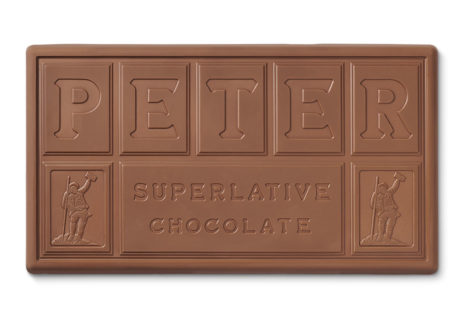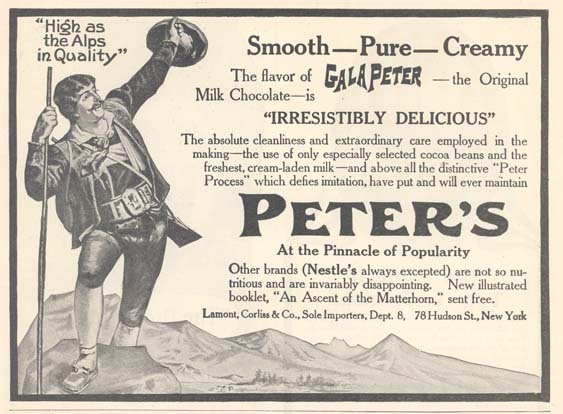Daniel Peter: The inventor who invented adding milk to chocolate
Daniel Peter represents a very important turning point in the history of chocolate, which was consumed as a bitter drink until the 19th century. Daniel Peter (1836–1919), Swiss businessman. He is known as the inventor of milk chocolate.

Thanks to the dehydration method he developed, Daniel Peter separated the water from the milk used in making chocolate, and beyond introducing a new product type to the market with milk chocolate, he changed the way chocolate is consumed. The Nestle Company, which they founded with Henri Nestle in 1879, developed many new product types thanks to this method and reached a great power in the chocolate market.
Who is Daniel Peter? (1836-1919)
Daniel Peter was born into a farming family in Moudon, in the Swiss Canton of Vaud, in 1836. His family wanted Daniel to get a good education, and they were mobilizing the opportunities they had. Little Daniel, keen on reading, was doing great in his studies. At the age of 16, he started working in Madam Clement's candle factory in Moudon. Later, he took his brother Julien with him and they worked together in the candle sales. The candles made by the Peter brothers were very popular in the town, and they had a good income from the sales. With the money they saved by selling candles, these two brothers bought a workshop on the Rue des Bosquets.
Daniel Peter, who grew candle production over time, married Fanny Cailler, the eldest daughter of the Cailler family, whom he met through Madam Clement, in 1863. His brother-in-law, August Cailler, had been working in the chocolate business for many years, trading raw materials for production. However, in this period, chocolate was consumed as a bitter drink and the demand for chocolate was very low. Daniel Peter had great success in candle making, mainly because the candles he produced were appreciated by the public. With the same logic in the chocolate business, he thought that if he could develop a product type that would be liked by the public, he could achieve great commercial success. He started to examine the raw materials he obtained through his brother-in-law in his laboratory.
The arrival of chocolate in Europe took place in the 16th century. Spanish explorers Christopher Columbus and Hernan Cortes brought a drink with them on their return from Central America. The name of this beverage, which the Mayans and Aztecs obtained by mixing ground cocoa beans with water, was "chikolatl", which means "sour" in Aztec language. Moreover, this drink was mixed with pepper and other spices and consumed cold. The Spaniards, who did not like the taste of this drink but were satisfied with the beautiful effects it created, preferred to consume it by adding some sugar.
Chocolate, which spread as a bitter drink consumed more among the elite in Europe over time, was an expensive drink due to the fact that cocoa beans were brought from America. The British, who found the taste of chocolate bitter, preferred to consume chocolate with milk, just like tea. According to Daniel Peter, consuming chocolate with milk reduced the bitterness of the chocolate's taste. However, it was necessary to turn it into a product type and gain public acceptance. The selling price of chocolate should also be in line with the purchasing power of the people. Thinking that if he could be successful in these matters, he could achieve a much greater commercial success than the sale of candles, Daniel Peter intensified his work on milk chocolate in a part of the factory.
In the 1840s, Daniel Peter had formed a strong friendship with his pharmacist neighbor Henri Nestle. In this period, Henri Nestle was doing various researches on oils, corn seeds and hazelnut oil, as well as running a pharmacy. These oils, which are used in industry as well as their therapeutic effect, had a wide range of uses from oil lamps to liqueurs. In this period, maternal and infant mortality rates were also at a very high level, and infant formula was one of the most deficient products. Henri Nestle was also trying to make a baby food that could replace breast milk by combining cow's milk with a special mixture. These studies gave positive results in 1867 and the world's first milk-based baby food was introduced to the market by Henri Nestle. These products were a great inspiration for Daniel Peter to develop milk chocolate.

Chocolate milk
In the 1870s, Daniel Peter made the idea of developing milk chocolate a passion. Entering the chocolate market with a new product type, controlled by the Cailler family as well as the Suchard and Kohler families, could change many things. Henri was getting various information about milk-based products from Nestle and expanding this information with his experiments. However, he still did not know enough about chocolate. He took a very important decision to fill the lack of information. And he started working as a worker in a chocolate factory in Lyon, France. He learned what was told to him in the factory where he worked for 2 weeks and returned to his country. Among the information he learned was very important information about the production of chocolate, as well as the harvest of cocoa and the basic components of cocoa.
After returning to his country, Daniel Peter gave up candle making and turned entirely into the chocolate business. In a short time, he succeeded in developing new product types whose raw materials consisted of cocoa, sugar and milk. However, a problem that Henri Nestle had faced before was too busy in his mind. The water and oil used in production did not mix well enough and did not provide a homogeneous mixture for the products. Reducing the amount of oil shortened the shelf life of the products, while increasing the amount of water caused the consistency to deteriorate. Henri Nestle had not been able to solve this problem before. Daniel Peter, on the other hand, thought that thanks to the knowledge he learned in Lyon, the water necessary for production could be obtained from the dehydration of milk, and the oil from cocoa beans.
However, it was very difficult to obtain the necessary equipment to realize them and required significant capital. Peter had no such capital. But the arrival of brothers George Page and Charles Page in Switzerland in 1873 was a very important opportunity for Daniel Peter. The Page brothers, who made very important discoveries in the field of concentrated milk, were very warm to Daniel Peter's milk chocolate idea and provided him with the necessary equipment support. Initial attempts did not yield the desired results, because he failed to lower the temperature in the environment he used as a dehydration chamber. After necessary refinements, Daniel Peter invented milk chocolate in 1875.
Daniel Peter and Henri Nestle
Daniel Peter, who invented milk chocolate, was conscious of the importance of this invention. He knew that it was necessary to immediately transform milk chocolate into a new product type and put it on the market, and to carry out advertising and promotional activities in order to increase sales. However, he did not have enough capital to realize them. However, Henri Nestle had made a big profit with baby food sales and had a significant power in the market. If he continued the milk chocolate business with Henri Nestle, both parties could profit greatly from this business.
In 1875, Daniel Peter told Henri Nestle about the milk chocolate he had developed. Henri Nestle, who welcomed this invention with interest and predicted that it would change the balance in the market, offered Daniel Peter to work together. Daniel Peter, who responded positively to the offer, succeeded in further developing the formula of milk chocolate with Henri Nestle, and in 1879 they founded the Nestle Company. The final formula of milk chocolate was developed by Daniel Peter in 1887. Nestle milk chocolates were both sweet and very soft, while retaining the taste of cocoa. Moreover, in terms of selling price, it was suitable for the purchasing power of the people.
In 1890, Henri Nestle died of a heart attack. Daniel Peter, on the other hand, continued his work on milk chocolate without interruption. In 1901, milk chocolate was introduced to the market in England. Three years later, Daniel Peter established a large milk chocolate factory in Orbe, Switzerland, and personally managed the operation of the factory until he passed away in 1919. In 1929, the factory was sold to Nestle by Daniel Peter's heirs.

